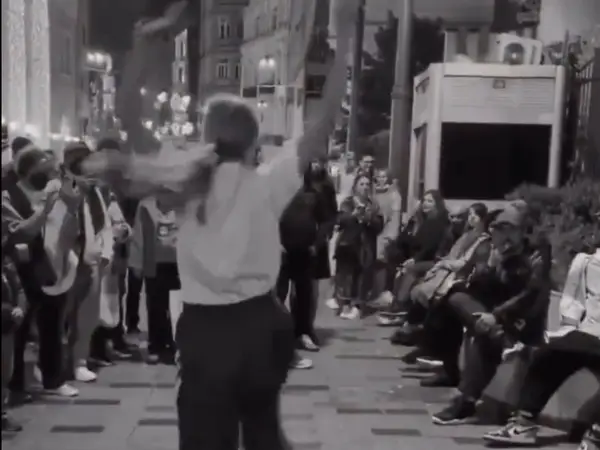Civil disobedience can take different forms, but in Iran where it has been banned for over four decades, dancing has become a non-violent form of protest.
The Islamic fasting month of Ramadan has coincided with Iran's extremely popular Nowrouz New Year Holidays this year but instead of fasting and praying as they are expected to do, many people seem to be determined to enjoy the holidays after months of violently suppressed protests. They want to show the government they have not been subdued.
Iranian holiday makers have been sharing videos of themselves dancing and making merry -- on the streets, at the beach, in shopping malls or in parks – in different parts of the country, even some very conservative areas, despite the unwritten ban on dancing in public that can get them into the trouble with the authorities.
Holiday makers watching a girl dance at the beach in Reyshahr in southern Iran
In most videos shared on social media, women are dancing with bare heads and not on their own but with men in the middle of a circle of clapping and cheering onlookers which make their defiance even more biting to the hardline religious and political establishment.
Quite often, the performances, particularly in crowded streets and shopping malls, appear to be very spontaneous with the dancers quickly disappearing into the crowds within a few minutes in flash mob style.
Most onlookers, as videos show, appear to be very happy and supportive of the dancers. In a few cases, they also chant “Woman, Life, Freedom”, the signature slogan of the 2022-23 protests, besides encouraging the dancers with clapping and singing along, and even showering them with money.
Girls dancing at a shopping mall in Jolfa, a small town in East Azarbaijan Province
In a few cases police has intervened to stop the performances and disperse the crowds. Weary of sparking fresh protests, authorities have shown some tolerance but at the same time tried to scare people into submission by shutting down some hospitality businesses while hardliners have complained that authorities are not taking sufficiently strong preventative action.
Police dispersing a crowd cheering a singing man and another who was dancing at Isfahan’s historical bridge during Nowrouz
In the tourist city of Amol earlier this week, the attorney general ordered a holiday resort to be shut down for women’s bareheaded dance in public in the month of Ramadan.
Similarly, the attorney general of Hamedan, Hassan Khanjani, ordered a café near the Ganjnameh Achaemenid inscriptions in the mountain outside the city to shut down. The café had “planned” music and dance programs for the visitors, he said, adding that two people were arrested in this connection for “encouraging others to depravity and moral corruption.”
Flash mob on a street in Karaj, 50km to the west of the capital Tehran
Hardliner ex-lawmaker Hamid Rasaei highlighted the videos of young girls dancing near Achaemenid inscriptions in Mount Behistun in the province of Kermanshah and protested to the ministry of cultural heritage and tourism for not acting to stop such infringements.
“Over 9,800 were martyred in Kermanshah province [in the Iran-Iraq war]… so that these places can be sensible places for families and to improve people’s historical understanding, not a place of dance,” Rasaei who likened the dance of a few young girls, who even had headscarves on, to “cabaret dancers” before the Islamic Revolution of 1979.
